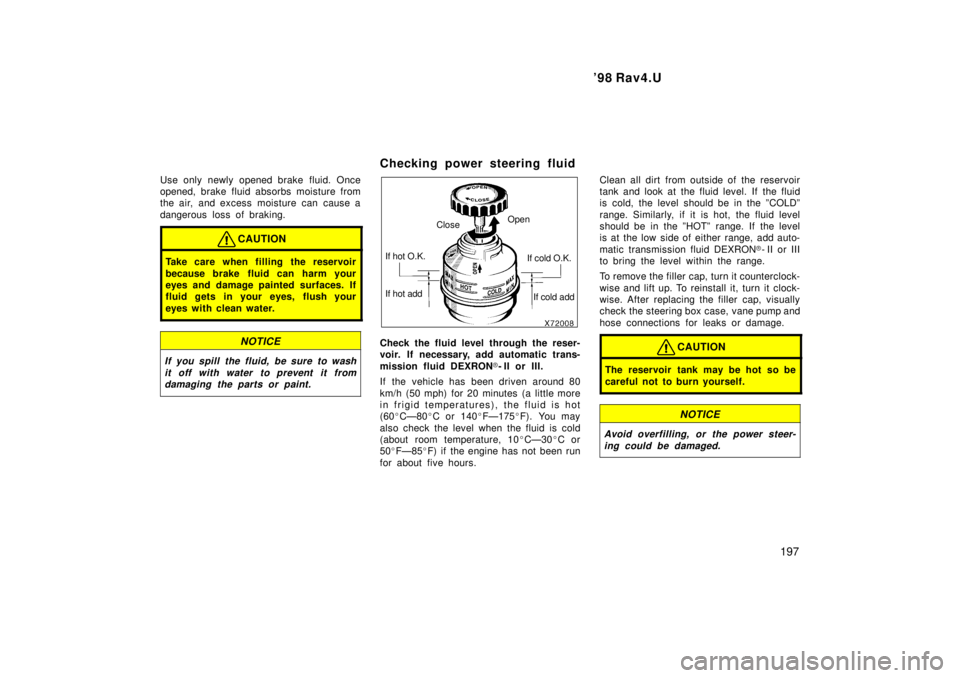Page 166 of 227
'98 Rav4U
166 3. Remove the wheel ornament.
Pry off the wheel ornament, using the
beveled end of the wheel nut wrench as
shown.
CAUTION
Do not try to pull the ornament by
hand. Take due care in handling the
ornament to avoid unexpected person-
al injury.
ÐLoosening wheel nuts
4. Loosen all the wheel nuts.
Always loosen the wheel nuts before rais-
ing the vehicle.
The nuts turn counterclockwise to loosen.
To get maximum leverage, fit the wrench
to the nut so that the handle is on the
right side, as shown above. Grab the
wrench near the end of the handle and
pull up on the handle. Be careful that the
wrench does not slip off the nut.
Do not remove the nuts yetÐjust unscrew
them about one- half turn. ÐPositioning the jack5. Position the jack at the following
jack points.
1 Front suspension arm rear mounting
2 Rear suspension arm
Make sure the jack is positioned on a
level and solid place.
Page 167 of 227
'98 Rav4.U167
ÐRaising your vehicle
6. After making sure that no one is in
the vehicle, raise it high enough so
that the spare tire can be installed.
Remember you will need more ground
clearance when putting on the spare tire
than when removing the flat tire.
To raise the vehicle, insert the jack handle
into the jack (it is a loose fit) and turn it
clockwise. As the jack touches the vehicle
and begins to lift, double- check that it is
properly positioned.
CAUTION
Never get under the vehicle when the
vehicle is supported by the jack
alone.
ÐChanging wheels
7. Remove the wheel nuts and change tires.
Lift the flat tire straight off and put it
aside.
Roll the spare wheel into position and
align the holes in the wheel with the bolts.
Then lift up the wheel and get at least the
top bolt started through its hole. Wiggle
the tire and press it back over the other
bolts.
Page 168 of 227

'98 Rav4U
168
Before putting on wheels, remove any cor-
rosion on the mounting surfaces with a
wire brush or such. Installation of wheels
without good metal- to- metal contact at the
mounting surface can cause wheel nuts to
loosen and eventually cause a wheel to
come off while driving. Therefore after the
first 1600 km (1000 miles), check to see
that the wheel nuts are tight. ÐReinstalling wheel nuts8. Reinstall all the wheel nuts finger
tight.
Reinstall the wheel nuts (tapered end in-
ward) and tighten them as much as you
can by hand. Press back on the tire back
and see if you can tighten them more. ÐLowering your vehicle9. Lower the vehicle completely and
tighten the wheel nuts.
Turn the jack handle counterclockwise to
lower the vehicle.
Use only the wheel nut wrench and turn
it clockwise to tighten the nuts. Do not
use other tools or any additional leverage
other than your hands, such as a hammer,
pipe or your foot. Make sure the wrench
is securely engaged over the nut.
Tighten each nut a little at a time in the
order shown. Repeat the process until all
the nuts are tight.
Page 197 of 227

'98 Rav4.U197
Use only newly opened brake fluid. Once
opened, brake fluid absorbs moisture from
the air, and excess moisture can cause a
dangerous loss of braking.
CAUTION
Take care when filling the r
eservoir
because brake fluid can harm your
eyes and damage painted surfaces. If
fluid gets in your eyes, flush your
eyes with clean water.
NOTICE
If you spill the fluid, be sure to wash
it off with water to prevent it fromdamaging the parts or paint.
Checking power steering fluid
Close Open
If hot O.K. If hot add If cold O.K.
If cold add
Check the fluid level through the reser-
voir. If necessary, add automatic trans-
mission fluid DEXRON �- II or III.
If the vehicle has been driven around 80
km/h (50 mph) for 20 minutes (a little more
in frigid temperatures), the fluid is hot
(60 �CÐ80 �C or 140 �FÐ175 �F). You may
also check the level when the fluid is cold
(about room temperature, 10 �CÐ30 �C or
50 �FÐ85 �F) if the engine has not been run
for about five hours. Clean all dirt from outside of the reservoir
tank and look at the fluid level. If the fluid
is cold, the level should be in the ºCOLDº
range. Similarly, if it is hot, the fluid level
should be in the ºHOTº range. If the level
is at the low side of either range, add auto-
matic transmission fluid DEXRON
�- II or III
to bring the level within the range.
To remove the filler cap, turn it c ounterclock-
wise and lift up. To reinstall it, turn it clock-
wise. After replacing the filler cap, visually
check the steering box case, vane pump and
hose connections for leaks or damage.
CAUTION
The reservoir tank may be hot so be
careful not to burn yourself.
NOTICE
Avoid overfilling, or the power steer-
ing could be damaged.
Page 222 of 227

'98 Rav4U
222
Fuses
Engine compartment (U.S.A.)
Fuses (type A) 1. H- LP (RH) 15 A: Right- hand headlight
2. H- LP (LH) 15 A: Left- hand headlight
3. SPARE 10 A: Spare fuse
4. SPARE 15 A: Spare fuse
5. AM2 5 A: Multiport fuel injection sys-
tem/sequential multiport fuel injection
system, SRS airbag system, seat belt
pretensioners, starting system, dis-
charge warning light
6. ALT- S 5 A: Charging system
7. HAZ 10 A: Emergency flashersEngine compartment (Canada)
8. EFI 20 A (U.S.A.) or 15 A (Canada): Multiport fuel injection system/sequen-
tial multiport fuel injection system
9. DOME 15 A: Interior light, personal
lights, clock, daytime running light sys-
tem, gauge and meters, car audio sys-
tem
10. IGN 20 A: Charging system
11. H- LP RH- H 10 A: Right- hand head-
light (high beam)
12. H- LP LH- H 10 A: Left- hand headlight
(high beam)
13. H- LP RH- L 10 A: Right- hand head-
light (low beam)Engine compartment
14. H- LP LH- L 10 A: Left- hand headlight
(low beam)
15. SEAT- HTR 10 A: No circuit
16. PWR OUTLET 15 A: Power outlet
17. CIG 15 A: Cigarette lighter, clock, car
audio system, power rear view mirrors,
electronically controlled automatic
transmission system
18. SRS- ACC 10 A: SRS airbag system,
seat belt pretensioners
19. WIPER 20 A: Windshield wipers and
washer, rear window wiper and washer
Page 223 of 227

'98 Rav4.U223
Instrument panel
20. ECU- IG 10 A: Electronically controlled
automatic transmission system, rear
window defogger, center differential
lock system, electric moon roof, multi-
port fuel injection system/sequential
multiport fuel injection system, electric
cooling fan, anti- lock brake system,
cruise control system
21. TURN & GAUGE 10 A: Turn signal
lights, gauges and meters, back- up
lights, service reminder indicators, air
conditioning system, daytime running
light systemInstrument panel
22. STOP 10 A: stoplights, high mounted
stoplight, electronically controlled auto-
matic transmission system, anti- lock
brake system
23. TAIL 15 A: Gauges and meters, emer-
gency flashers, cigarette lighter, center
differential lock system, clock, rear win-
dow defogger, air conditioning system,
electronically controlled automatic
transmission system, car audio system,
tail lights, license plate lights, parking
lights, instrument panel light control,
side marker lights
24. OBD 10 A: On- board diagnosis system
25. SRS- B 10 A: SRS airbag warning lightPassenger's side kick panel
26. HORN 10 A: Horn
27. DEFOG 20 A: Rear window defogger
28. AM1 10 A: ºCIGº, ºPWR OUTLETº,
ºSRS- ACCº, ºWIPERº, ºECU- IGº and
ºTURN & GAUGEº fuses
29. A/C 10 A: Air conditioning system
Fuses (type B)
30. MAIN No.1 40 A: Starting system, ºH-
LP (RH)º, ºH- LP (LH)º, ºH- LP RH- Hº,
ºH- LP LH- Hº, ºH- LP RH- Lº and ºH- LP
LH- Lº fuses
31. CDS FAN 30 A: Electric cooling fans
32. RDI FAN 30 A: Electric cooling fans